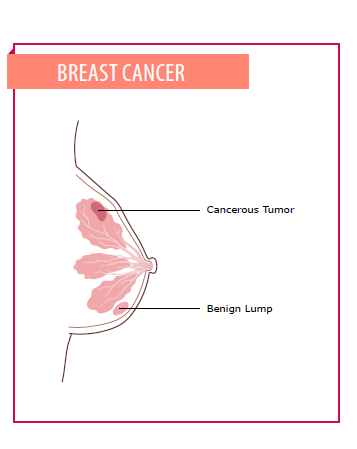What is Breast Cancer?
Causes / Etiology of Breast Cancer
As the name suggests, it is a cancer that affects the breasts or mammary glands. In technical terms it is a carcinoma of the breast which is either ductal or lobular. It is a breast malignancy which is more prominent in females than males and is the second most frequent cause of cancer death.
The etiology is complex as there are different risk factors involved. Risk of breast cancer is higher in women above the age of 50 with an early detection and change in lifestyle, it can be controlled.
Breast Cancer Facts
- Breast cancer is 100 times more frequent in women in comparison to men.
- Prognosis is the same in both.
- Most common cancer in women - the incidence rate among females is twice as much as that of
- colorectal cancer and cervical cancer and approximately three times that of lung cancer.
- Globally, the incidence of breast cancer is the highest among American women.
- About 16% of women between the age of 40-60 years have breast-related problems. Of these
- 40% complain of breast lumps.
- In women over 40 years, these breast lumps may carry a risk of breast cancer.
- However, the majority of these breast- related complaints may be due to benign breast disease.
Causes / Etiology of Breast Cancer
Causes / Etiology of Breast Cancer
Breast cancer, like other forms of cancer, is considered to be the final outcome of a legion of environmental and hereditary factors. However, the exact cause is not known. It is suspected that more than one factor is involved. The risk of breast cancer also increases, as a woman gets older.
Personal and family history of breast cancer
Late parity
Early age menstruation & late menopause
Breast Density & Obesity
Exposure to radiation
Alcohol & Tobacco usage
Oral contraceptive & oestrogen pills
Hormone replacement therapy (HRT)
History of benign breast disease
Chemicals & Gene mutations Several other environmental and lifestyle factors
Breast Density & Obesity
Exposure to radiation
Alcohol & Tobacco usage
Oral contraceptive & oestrogen pills
Hormone replacement therapy (HRT)
History of benign breast disease
Chemicals & Gene mutations Several other environmental and lifestyle factors
Signs & Symptoms
High risk group
Breast cancer patients are divided into several groups based on their conditions. The following are the several risks of this ailment:
In today’s date the TNM (Tumor, Nodes, Metastases) Classification is recognized and accepted worldwide which takes into consideration the tumour itself, the involvement of the lymph nodes and the metastasis to other body parts. The prognosis and treatment which suits best to the patient is closely connected to
the stage of the tumour.
the stage of the tumour.
Diagnosis
The identification of this disease can be done by examining the symptoms in the following ways -
Clinical Breast Examination - A self breast examination can be done or else a thorough clinical exam which can
reveal any lump if formed.
Mammograms - A low radiation X-Ray therapy used to detect breast cancer prior to the appearance of symptoms.
Ultrasonography - Reveals if the lump is fluid filled cyst(not cancer) or a solid mass(might or might not be cancer).
Magnetic Resonance Imaging (MRI) - Defines the size & extent of cancer within the breast tissue.
Digital Mammography - Similar to standard mammography but advantageous of digital storage of images
& enhancement by brightness & contrast modification.
Biopsy - Done to collect a tissue sample to be examined under the microscope.
Fine Needle Aspiration - Fluid and/or cells removed from a breast lump using a thin needle.
Needle Biopsy - Tissue removal using a needle from a suspicious area on a mammogram which can’t be felt.
Stereotactic Needle Biopsy - uses a mammogram directed technique to map the exact location of the breast lump.
Surgical Biopsy - Cutting out a sample or all of a lump of a suspicious area.
reveal any lump if formed.
Mammograms - A low radiation X-Ray therapy used to detect breast cancer prior to the appearance of symptoms.
Ultrasonography - Reveals if the lump is fluid filled cyst(not cancer) or a solid mass(might or might not be cancer).
Magnetic Resonance Imaging (MRI) - Defines the size & extent of cancer within the breast tissue.
Digital Mammography - Similar to standard mammography but advantageous of digital storage of images
& enhancement by brightness & contrast modification.
Biopsy - Done to collect a tissue sample to be examined under the microscope.
Fine Needle Aspiration - Fluid and/or cells removed from a breast lump using a thin needle.
Needle Biopsy - Tissue removal using a needle from a suspicious area on a mammogram which can’t be felt.
Stereotactic Needle Biopsy - uses a mammogram directed technique to map the exact location of the breast lump.
Surgical Biopsy - Cutting out a sample or all of a lump of a suspicious area.
Prevention
May how appalling this disease be, there are certain preventive measures proposed to keep breast cancer at bay.
Prevention
Treatment
The choice of treatment depends on factors like the extent to which the cancer has spread, characteristics of the cancer & physical condition of the patient.
The two common options are surgery and therapy.
The main mode of treatment for breast cancer, especially so when the tumour is localized is surgery. It must be noted that even through breast cancer is of the breast, the cancer can spread to other body parts which is why breast cancer’s treatment almost always involves surgery.
Treatment
A surgery is often followed up by other treatments to be mentioned below which depends on the risk status of the patient’s cancer – high or low risk. Factors like, the patient’s age, type and size of cancer, metastasis of the disease decides the risk status of the patient.
Other treatment possibilities include Chemotherapy, Radiation Therapy, Hormone Therapy and Immune Therapy.











No comments:
Post a Comment